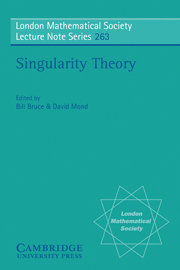 Singularity Theory
Singularity Theory Published online by Cambridge University Press: 05 May 2013
Dedicated to Professor C. T. C. Wall on his 60th birthday.
Introduction
This is a survey article concerning the authors' papers [47], [33], [50], [51], [52], [53], where the following problem is considered: Given a smooth map f: M → N between smooth manifolds, does there exist a smooth map homotopic to f which has no singularities of a prescribed type Σ? It is known that this problem is almost equivalent to the existence problem of a corresponding jet section M → Jr(M, N) covering f, which is homotopy theoretic in nature (for example, see [30], [28], [20], [21], [15], [16], [17] etc.). However, this homotopy theoretical problem is usually very difficult to solve, since even the homotopy type of the corresponding fiber in the jet bundle is difficult to determine.
The most easily computed part of an obstruction to the existence of a corresponding jet section is the Thom polynomial, which is the homology class represented by the closure of the set Σ(f) of the singular points of f of type Σ [58], [31]. In fact, in some cases, it has been shown that the vanishing of the Thom polynomial implies the existence of a map homotopic to f without the prescribed singularities: for example, H. Levine's cusp elimination theorem for maps into the plane [35] and its generalizations to some 0-dimensional singularities by Ando [5], [6].
To save this book to your Kindle, first ensure no-reply@cambridge.org is added to your Approved Personal Document E-mail List under your Personal Document Settings on the Manage Your Content and Devices page of your Amazon account. Then enter the ‘name’ part of your Kindle email address below. Find out more about saving to your Kindle.
Note you can select to save to either the @free.kindle.com or @kindle.com variations. ‘@free.kindle.com’ emails are free but can only be saved to your device when it is connected to wi-fi. ‘@kindle.com’ emails can be delivered even when you are not connected to wi-fi, but note that service fees apply.
Find out more about the Kindle Personal Document Service.
To save content items to your account, please confirm that you agree to abide by our usage policies. If this is the first time you use this feature, you will be asked to authorise Cambridge Core to connect with your account. Find out more about saving content to Dropbox.
To save content items to your account, please confirm that you agree to abide by our usage policies. If this is the first time you use this feature, you will be asked to authorise Cambridge Core to connect with your account. Find out more about saving content to Google Drive.